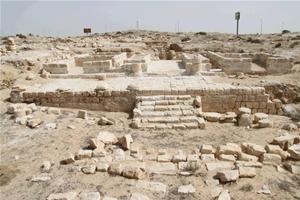Polish archaeologists and restorers returned from Marina el-Alamein
PAP - Science and Scholarship in Poland
Source - http://www.naukawpolsce.pap.pl/en/news/news,396467,polish-archaeologists-and-restorers-returned-from-marina-el-alamein.html

Mausoleum T21 after restoration. Photo by: Rafał Czerner
This year's research and restoration was conducted in May by the Polish-Egyptian Preservation Mission in the necropolis and the representative part of the city from Hellenistic and Roman times. The most interesting discoveries were made within the area of ancient baths.
"Unfortunately, due to the particular period of transition still ongoing in Egypt, the duration of the mission was limited. Despite this, we continued studies and restoration of Roman baths south of the central square and connected city basilica. We have also secured remnants of the mausoleum of one of the tombs, the most monumental in the necropolis, and performed conservation of the most valuable wall paintings" - told PAP Prof. Rafał Czerner the Faculty of Architecture, Wrocław University of Technology, leader of the expedition.

Southern baths, general view (latrine 12 and courtyard 4) after conservation. Photo by: Rafał Czerner
Efforts of the mission have focused on the baths and the city's basilica. The area had been previously surveyed in part by the Polish of the mission led by Professor Wiktor A. Daszewski and Egyptian archaeologists.
"Building solutions of the baths are an interesting research topic, yielding at the interesting discoveries and conservation tasks every year" - said Prof. Czerner.

Baths south. East hall and the southern part of the city basillica after the unveiling and conservation. Photo by: Rafał Czerner
The researchers focused on understanding the functional layout of the baths. This year, they uncovered and secured rich remains of a latrine. According to experts, it was a carefully and elegantly built room. They even found the remains of polychrome plaster.
"Large marble slabs that line the floor and the lower parts of the walls have been preserved. The latrine retained all the functional elements. However, they required protection and reconstruction. Remnants of the latrine are the most interesting discovery of the season" - considers head of the mission.

Southern baths. The latrine room (No. 12) after the unveiling and conservation. Photo by: Rafał Czerner
Within the baths, scientists have also found lost items - a small ring made of bronze with inscription, and another with a stone eye.
"We have also undertaken conservation of wall painting, which has been stored for several years in storage. This includes fragments of painting with the presentation of Helios, Harpocrates and Sarapis" - said Prof. Czerner.

Presentation of Helios, Harpocrates and Sarapis before and after conservation. Photo by: Rafał Czerner
Archaeological site of today's Marina el-Alamein in Egypt is located on the Mediterranean coast, 100 km west of Alexandria. These are extensive remains of the ancient harbour sediments. Scientists are uncertain of its name in ancient times. Based on the descriptions made by ancient geographers, it can be assumed that this was the city of Antiphrai and harbour Leukaspis, which eventually merged into one administrative unit.
In Marina el-Alamein, there are remains of the city with its residential buildings, public buildings, thermal baths, basilica, streets, central square, port buildings and extensive necropolis of monumental memorials, mausoleums and underground tombs. However, only a small portion has been studied archaeologically.
It was the eighteenth season of work of the Polish-Egyptian Preservation Mission. Another team from Poland also works on site - Polish Archaeological Mission in Marina el-Alamein, now led by Dr. Krzysztof Jakubiak from the Institute of Archaeology, University of Warsaw.